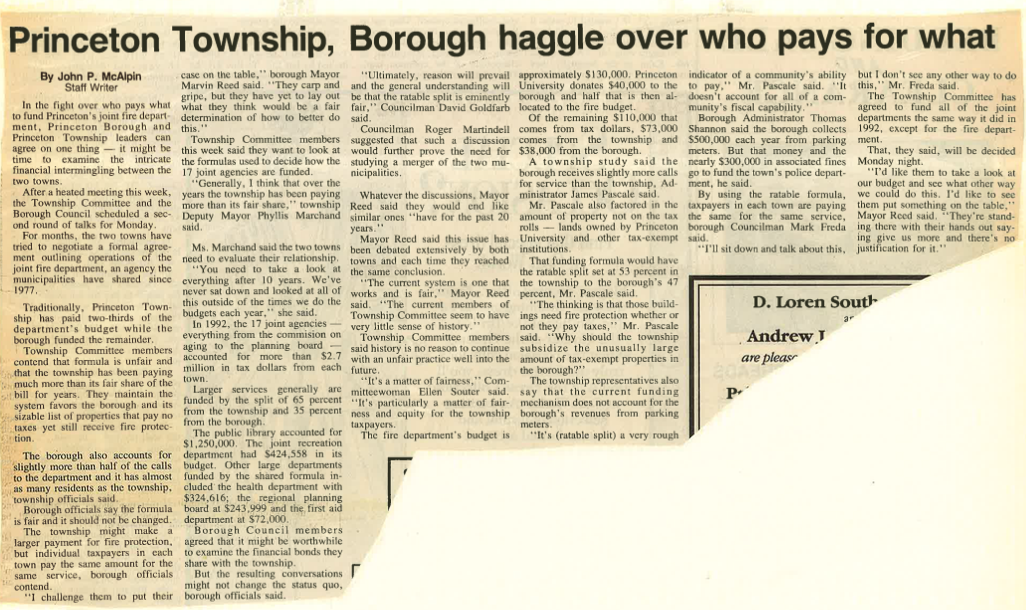 April 30, 1993 (~estimated)
April 30, 1993 (~estimated)
Princeton Township, Borough haggle over who pays for what
By John P. McAlpin
Staff Writer
In the fight over who pays what to fund Princeton’s joint fire department, Princeton Borough and Princeton Township leaders can agree on one thing — it might be time to examine the intricate financial intermingling between the two towns.
After a heated meeting this week, the Township Committee and the Borough Council scheduled a second round of talks for Monday. For months, the two towns have tried to negotiate a formal agreement outlining operations of the joint fire department, an agency the municipalities have shared since 1977.
Traditionally, Princeton Town-ship has paid two-thirds of the department’s budget while the borough funded the remainder.
Township Committee members contend that formula is unfair and that the township has been paying much more than its fair share of the bill for years. They maintain the system favors the borough and its sizable list of properties that pay no taxes yet still receive fire protection.
The borough also accounts for slightly more than half of the calls to the department and it has almost as many residents as the township, township officials said.
Borough officials say the formula is fair and it should not be changed.
The township might make a larger payment for fire protection, but individual taxpayers in each town pay the same amount for the same service, borough officials contend.
“I challenge them to put their case on the table,” borough Mayor Marvin Reed said. “They carp and gripe, but they have yet to lay out what they think would be a fair determination of how to better do this.”
Township Committee members this week said they want to look at the formulas used to decide how the 17 joint agencies arc funded.
“Generally, I think that over the years the township has been paying more than its fair share,” township Deputy Mayor Phyllis Marchand said.
Ms. Marchand said the two towns need to evaluate their relationship.
“You need to take a look at everything after 10 years. We’ve never sat down and looked at all of this outside of the times we do the budgets each year,” she said.
In 1992, the 17 joint agencies —everything from the commision on aging to the planning board —accounted for more than $2.7 million in tax dollars from each town.
Larger services generally are funded by the split of 65 percent from the township and 35 percent from the borough.
The public library accounted for $1,250,000. The joint recreation department had $424,558 in its budget. Other large departments funded by the shared formula included the health department with $324,616; the regional planning board at $243,999 and the first aid department at $72,000.
Borough Council members agreed that it might be worthwhile to examine the financial bonds they share with the township. But the resulting conversations might not change the status quo, borough officials said.
“Ultimately, reason will prevail and the general understanding will be that the ratable split is eminently fair,” Councilman David Goldfarb said.
Councilman Roger Martindell suggested that such a discussion would further prove the need for studying a merger of the two municipalities.
Whatever the discussions, Mayor Reed said they would end like similar ones “have for the past 20 years.” Mayor Reed said this issue has been debated extensively by both towns and each time they reached the same conclusion.
“The current system is one that works and is fair,” Mayor Reed said. “The current members of Township Committee seem to have very little sense of history.”
Township Committee members said history is no reason to continue with an unfair practice well into the future.
“It’s a matter of fairness,” Com-mitteewoman Ellen Souter said. “It’s particularly a matter of fairness and equity for the township taxpayers.
The fire department’s budget is approximately $130,000. Princeton University donates $40,000 to the borough and half that is then allocated to the fire budget.
Of the remaining $110,000 that comes from tax dollars, $73,000 comes from the township and $38,000 from the borough.
A township study said the borough receives slightly more calls for service than the township, Administrator James Pascale said.
Mr. Pascale also factored in the amount of property not on the tax rolls — lands owned by Princeton University and other tax-exempt institutions.
That funding formula would have the ratable split set at 53 percent in the township to the borough’s 47 percent, Mr. Pascale said.
“The thinking is that those buildings need fire protection whether or not they pay taxes,” Mr. Pascale said. “Why should the township subsidize the unusually large amount of tax-exempt properties in the borough?”
The township representatives also say that the current funding mechanism does not account for the borough’s revenues from parking meters.
“It’s (ratable split) a very rough indicator of a community’s ability to pay,” Mr. Pascale said. “It doesn’t account for all of a community’s fiscal capability.”
Borough Administrator Thomas Shannon said the borough collects $500,000 each year from parking meters. But that money and the nearly $300,000 in associated fines go to fund the town’s police department, he said.
By using the ratable formula, taxpayers in each town are paying the same for the same service, borough Councilman Mark Freda said.
“I’ll sit down and talk about this, but I don’t see any other way to do this,” Mr. Frcda said.
The Township Committee has agreed to fund all of the joint departments the same way it did in 1992, except for the fire department.
That, they said, will be decided Monday night.
“I’d like them to take a look at our budget and see what other way we could do this. I’d like to see them put something on the table,” Mayor Reed said. “They’re standing there with their hands out saying give us more and there’s no justification for it.”